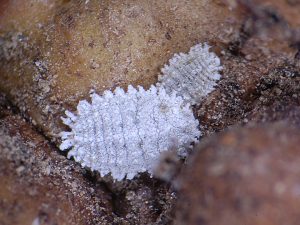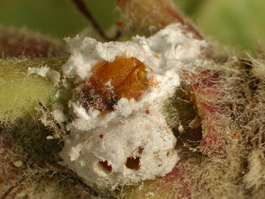by Elizabeth H. Beers, published online December 2007
Phenacoccus aceris Signoret (Homoptera: Pseudococcidae)

Apple mealybug is thought to be European in origin, but currently its distribution is cosmopolitan. It was likely introduced into North America (Maine) sometime before 1910 on infested nursery stock. Most of the early literature on this pest concerns outbreaks in Nova Scotia and British Columbia in the 1930s. A parasitoid was discovered in the late 1930s in Nova Scotia, and found to be very successful in controlling apple mealybug. The parasitoid was sent to British Columbia, and this introduction was also considered a very successful example of classical biological control. In the Pacific Northwest, apple mealybug is currently recorded from British Columbia, Washington, Oregon, and California.
Much of the recent literature on apple mealybug concerns its role as the vector of little cherry virus (specifically, little cherry virus 2). The spread of the virus is regulated in British Columbia, which was first found in 1933. This virus was widespread and devastating in Kootenay cherry growing region. While propagation is thought to be the most common form of spread, control of apple mealybug is also specified.
This pest is currently fairly rare in Washington orchards, but where is occurs, it may be quite abundant. Although the host range includes all tree fruits, recent finds (past 10 years) have been in apple orchards, several of which were under organic management. Known Washington populations occur in Okanogan, Douglas, Chelan, and Grant counties.
Hosts
Despite the common name of “apple” mealybug, this insect is by no means a specialist. The host range is very broad, including all deciduous fruit and nut trees (apple, cherry, pear, plum, apricot, filbert), small fruits (grape, currant, gooseberry, blueberry) many shade trees (maple, oak, birch, willow, ash, linden, elm, mountain ash) and various ornamentals (cotoneaster, hawthorn, quince, spirea). The alternative common name, the polyphagous tree mealybug, is more indicative of this broad host range.
Life stages
Eggs
The eggs are oval, ca. 0.3 mm long, and lemon yellow in color. Eggs are laid in ovisacs or nests consisting of dense cottony material covering a mass of separate eggs. The nests are 4-9 mm long, 1-3 mm wide, and can be found on the trunk, twigs, or leaves of apple. The ovisacs contain up to several hundred eggs. Apple mealybug nests can be distinguished from grape mealybug nests by their appearance: the grape mealybug is a loose, cottony mass, whereas the apple mealybug’s nest is a well-defined cottony cylinder.
Nymphs
The first instar nymph is lemon yellow like the egg, and about the same size (0.3-0.4 mm), but with bright red eyes. Nymphs remain in the nest for a while, and gradually disperse to nearby plant tissues. Soon after they begin feeding, they develop the “mealy” coating (a granular white waxy covering) waxy filaments at the caudal end that is typical of mealybugs. This is well developed in later instars.
Adults
The adult female is 3-4 mm long, with a sage green body color visible through the white waxy coating. The “tails” on the caudal end of the mealybug are shorter than those of grape mealybug, and the body color (green vs pale purple) distinguishes it from grape mealybug, the most common mealybug pest in Washington tree fruits. The male is a typical of the Coccoidea, winged and relatively delicate.
Life History
All reports in the literature specify one generation per year. The information from the Pacific Northwest is scarce, thus much of the information is taken from other areas. The apple mealybug overwinters as a second instar nymph in a cocoon under bark scales or in cracks in the bark. Feeding is done by inserting the proboscis into plant tissues (bark or leaves) and sucking plant sap. They emerge from overwintering sites very early in the spring, feed on twigs, mature to the adult stage (male and female) and mate. Egglaying begins in early May in central Washington.

The mealybugs appear to be quite indiscriminate about their oviposition sites; many of the nests are on twigs, especially in the crotches; some are in pruning scars on heavy wood, and some are on the leaves (underside is common, but they can also be found on the upper surface). In heavy infestations, nests can be found on twine used for tree training, or dead leaves. Multiple nests are frequently laid overlapping each other, especially in the crotches of twigs. Just before laying her eggs, the female becomes sedentary, and develops a loose, fluffy covering of waxy filaments. Eggs are laid, and the ovisac constructed as she moves along. The female may construct more than one ovisac, but most frequently, the female can be found at one end of the ovisac, where she eventually dies. Initially the female in the nest will retain the sage green color, but becomes progressively more yellow as she begins to dessicate. Eggs begin to hatch in early June, although crawlers may not emerge from the nests immediately. Gradually, they disperse to nearby tissues (leaves, especially near the midribs; twigs; leaf axils, and fruit) and begin feeding. Nymphs grow slowly over the course of the summer, and partially grown nymphs seek overwintering quarters in the fall.
Damage

Sucking sap will to some exent devitalize the tree, although this is probably the least of management concerns. Like most sap-feeders, this insect produces honeydew (a high-sugar fluid excrement) that can serve as a substate for sooty mold. The production of honeydew which can drip on fruit is of more concern, and more likely to require control. In addition, apple mealybug can also directly infest and feed on fruit, possibly becoming a direct pest or quarantine concern.
Monitoring
There are no formal schemes for monitoring apple mealybug. When they are abundant, the egg sacs are quite apparent, and will give an indication if later control is required. In some cases, only a few areas in an orchard may have sufficiently heavy populations to merit control.
Biological Control
Parasites are likely the most effective biocontrol agents of apple mealybug. The best known parasitoid is Allotropus utilis Muesbeck, a platygastrid wasp discovered and named in 1939 in Nova Scotia. This species was exported to British Columbia (in 1938), where it became well established. This was considered one of the outstanding successes of classical biological control. Worldwide, this mealybug has been attacked by several encyrtid wasps (Anagyrus, Aphycus, Pseudaphycus, etc). The impact of predators is not well studied. Predators include many of the generalists (lady beetles, lacewings, and predatory bugs such as Deraeocoris spp. and campylomma) and a chamaemyiid midge (Leucopis).

Information on the natural enemy complex in Washington is scarce. A parasitic wasp (probably an Anagyrus sp) was found attacking a heavy infestation of apple mealybug in an organic orchard. A high percentage of the overwintering generation was parasitized. Interestingly, the female mealybug could lay viable eggs despite being the host for one or more adult parasitoids. The females and males of this parasitoid species have very different appearances, and may be mistaken for separate species. Adult parasitoid emergence occurred about the same time as egg hatch of the mealybugs.
Management
Control recommendations in Washington are speculative at this point. The recommendations on cherry, in an area where the virus is known to occur, should be more stringent. British Columbia recommends controls at dormant, petal fall, summer and post harvest. Control recommendations in other crops can be more in line with population density. Dormant or delayed dormant sprays should reduce the population if they have emerged from their overwintering sites. The period of crawler emergence in early to mid-June is likely another vulnerable point in the life cycle, although no control studies on apple in this region have been done. Conventional insecticides and insect growth regulators used against grape mealybug are likely effective. In organic orchards, neem insecticides, timed for crawler emergence, appear to provide some control. Spray practices (e.g., high gallonage) that cover the undersides of the leaves and crevices in the bark will likely be more effective. Once they begin feeding, mealybugs are not very mobile, and they will not move around to contact a sparsely applied spray. Avoiding pesticides that destroy parasitoids should also help keep this species at a low level.
Apple Mealybug Gallery
References
British Columbia Ministry of Agriculture and Lands. Apple mealybug, Phenacoccus aceris (Signoret).
British Columbia Ministry of Agriculture and Lands. British Columbia Ministry of Agriculture and Lands. 2007. Little cherry disease in British Columbia.
Chachoria, H. S. 1967. Mortality in apple mealybug, Phenacoccus aceris (Homoptera: Coccidae), populations in Nova Scotia. The Canadian Entomologist 99: 728-730.
Eastwell, K. C., and M. G. Bernardy. 2001. Partial characterization of a closterovirus associated with apple mealybug-transmitted littel cherry diseas in North America. Phytopathology 91: 268-273.
Gilliatt, F. C. 1935. A mealy bug, Phenacoccus aceris Signoret, a new apple pest in Nova Scotia. The Canadian Entomologist 67: 161-164.
Gilliatt, F. C. 1936. Observations on the mealy bug, Phenacoccus aceris Sig. The Canadian Entomologist 68: 133.
Gilliatt, F. C. 1939. The life history of Allotropa utlilis Mues., a Hymentoperous parasite of the orchard mealy bug in Nova Scotia. The Canadian Entomologist 71: 160-161.
Kozar, F., L. M. Humble, R. G. Foottit, and I. S. Orvos. 1989. New and little known scale insect (Homoptera: Coccoidea) from British Columbia. Journal of the Entomological Society of British Columbia 86: 70-77.
Madsen, H. F., and P. J. Proctor. 1982. Insects and mites of tree fruits in British Columbia, pp. 1-70. Ministry of Agriculture and Food, Victoria, B.C.
Marshall, J., and A. D. Pickett. 1944. The present status of the apple mealybug, Phenacoccus aceris Sig., in British Columbia and Nova Scotia [Note]. The Canadian Entomologist 76: 19.
Marshall, J. 1953. A decade of pest control in British Columbia. Proceedings of the Entomological Society of British Columbia 49: 7-11.
Muesbeck, C. F. W. 1939. A new mealybug parasite (Hymenoptera: Scelionidae). The Canadian Entomologist 71: 158-160.
Raine, J., R. D. McMullen, and A. R. Forbes. 1986. Transmission of the agent causing little cherry disease by the apple mealybug Phenacoccus aceris and the dodder Cuscuta lupuliformis. Canadian Journal of Plant Pathology 8: 6-11.
Turnbull, A. L., and D. A. Chant. 1961. The practice and theory of biological control of insects in Canada. Canadian Journal of Zoology 39: 697-753.



